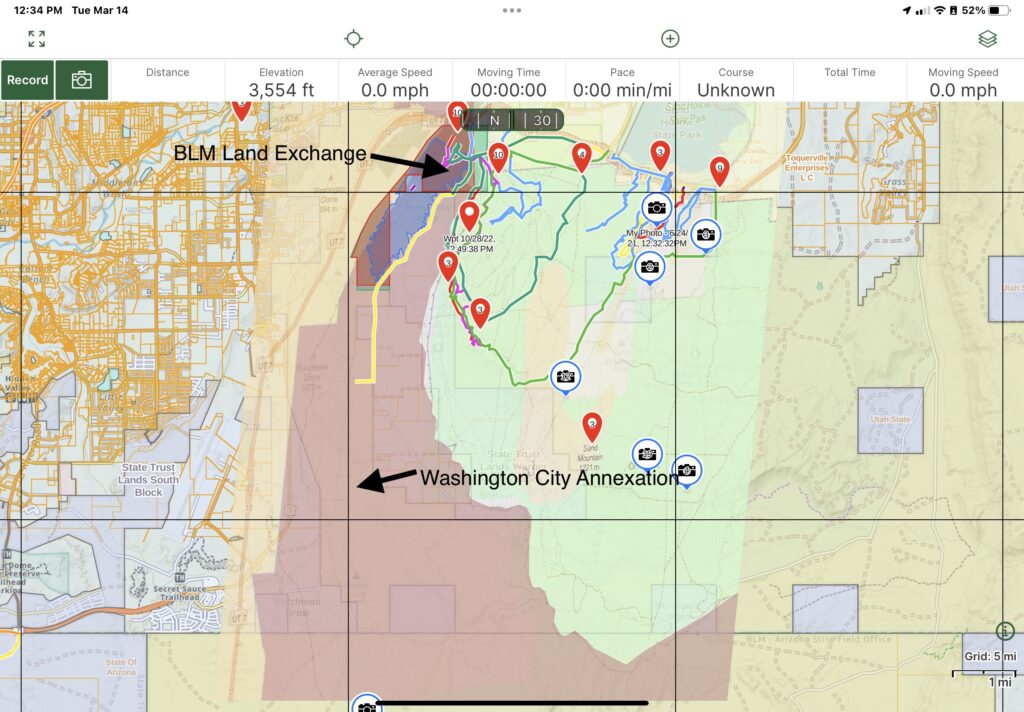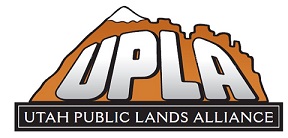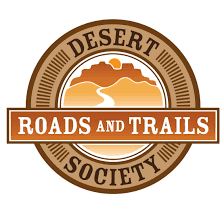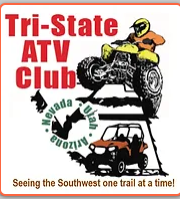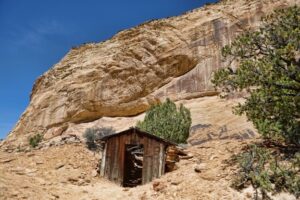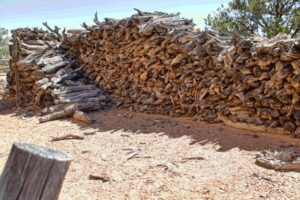Read these Tips Before Sending Your Comments to Stop the Sale
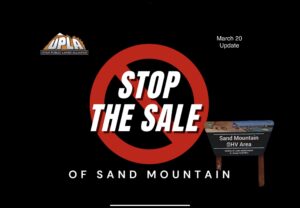 Scoping is underway for the proposed Land Exchange for the Washington County Water Conservancy District to obtain 1050 acres of land from the Western portion of Sand Mountain OHV area near Warner Valley. Part of this may be to provide land for the new reservoir, to which we have no objection, but we are in opposition to the addition of the land east of Warner Valley Rim which would affect West Rim and Ridgeline Trails. You can learn more about the latest details at www.UtahPLA.com
Scoping is underway for the proposed Land Exchange for the Washington County Water Conservancy District to obtain 1050 acres of land from the Western portion of Sand Mountain OHV area near Warner Valley. Part of this may be to provide land for the new reservoir, to which we have no objection, but we are in opposition to the addition of the land east of Warner Valley Rim which would affect West Rim and Ridgeline Trails. You can learn more about the latest details at www.UtahPLA.com
What is Scoping? The National Environmental Policy Act (NEPA) requires the Bureau of Land Management (BLM), to involve the public in the planning process and seek their input through a scoping process, which is one of the first steps of the process. It will be followed by BLM’s preparation of a draft Environmental Assessment (EA) , and you will have another opportunity to add substantive comments. Effective NEPA scoping comments for BLM should ask these kind of questions, some thought starters have been included in italics, but come up with your own questions, please don’t just copy this list, put it into your own words.
- Provide specific information about the proposed action, including its location, purpose and need, and potential environmental impacts.
- We understand the purpose of the reservoir use, but what is the purpose of the large acquisition east and north of the reservoir?
- We asked the Water Conservancy District and City of Washington what they plan to use the land for, and their response has been they have no plans or it’s too early to have thought about it. BLM should demand a clear direction from the City of Washington as to their involvement and precise plans for the future.
- How will it affect visitors and their economic impact to the region?
- Adjoining lands that are managed by different agencies often cause conflicts because of differences in rules governing that use, and law enforcement. If the “dispersed” camping is eliminated at Washington Dam, law enforcement issues may rise with those people desiring free camping will arise in other areas, i.e. our Waddy’s Corral staging area may have people trying to camp there, especially after we pave the road to it. Much of the increase in OHV recreation has come from UTV/ATV users, who need staging areas to unload and park their machines. Where do they go if Washington Dam is closed?
- What will be the Visual Resource Impacts of the change. Currently, most of Sand Mountain is classified as Class 2, but it appears from Map 2.14 in the BLM St George Field Office 1999 Recreation Management Plan that the West Rim is classified as Class 3. How will you ensure that the basic characteristics and visual appearance will be maintained if the exchange is approved?
- Identify any alternatives that the BLM should consider, including no action, and explain why they would be preferable or less impactful.
- What other locations may have been considered for the exchange located north and east of the reservoir?
- Have you considered alternatives that eliminate the areas east of the reservoir.
- Have you considered replacing our area of concern with land to the south of the proposed reservoir location, where WCWCD is planning for recreation already.
- What other alternatives have you considered for acquiring the 89 acre Non Federal parcel.
- If no action is recommended as an alternative, please provide precise details what that means.
- Highlight any potential significant impacts that may result from the proposed action and suggest ways to mitigate or avoid them.
- Without knowing what the new use will be, how can you clearly analyze potential impacts or mitigations.
- How do you propose to resolve impacts such as user conflicts between OHV and development or noise or traffic concerns.
- Although a State Park, California’s Oceano Dunes OHV users have been attacked by new residents building communities adjacent to the Dunes because of User Conflicts. What consideration have you given that the transfer could lead to even further losses if undetermined future users complain about current OHV use such as noise, traffic, or blowing sand.
- Provide relevant scientific data, studies, or other sources of information to support the comments.
- Oceano Dunes is a great example of how user conflicts were created that led to further losses to OHV.
- In many communities, airports have come under attack from new communities built around them that complain about the noise, ultimately resulting in the closure of 378 airports since 1990, almost 7% of the total.
- How will the appraisal reflect the value of Recreation?
- Address the scope of the proposed action, including any indirect or cumulative effects that may result from the action.
- How will access to the public lands on top of Warner Ridge and West Rim be accomplished.
- What will be the impact of the loss of staging and dry camping in the area?
- What will be the impact on OHV traffic patterns from the recently constructed Waddy’s Corral Staging area.
- Why are you giving more land than needed for the reservoir?
- Where will the people that use the disbursed camping sites on Pipeline Road go to?
- Where will the campers using Washington Dam free camping area go?
- There are often many conflicts when different land managers are in charge of adjacent areas, who is going to manage the acquired land, and what is their experience at working with BLM?
- How will the view sheds from the West Rim trail and above be impacted by the change?
- The OHV Area loss from this is 1050 acres, plus an additional loss of almost 400 acres if the reservoir project proceeds in a future request. This is in addition to the indirect and direct cumulative effects from various options from the 2016 Lake Powell Project proposal, ranging from 60 to 290 additional acres of land being closed to OHV use. This brings the total OHV loss to 1740 acres from the Sand Mountain SMRA. What other options have you considered?
- Identify any potential environmental justice concerns that may arise from the proposed action, such as impacts on low-income or minority communities.
- How will the loss of free and disbursed camping affect users of lower income?
- Discuss any potential cultural or historical impacts on Native American tribes or other affected communities.
- What cultural, anthropological, and historical impacts will result from this Proposed Exchange?
- Offer specific suggestions for how the BLM can address public concerns and incorporate feedback into the decision-making process.
- While we appreciate the extension for comments of 6 days, there are many visitors that come at different times of the year, and it will take time to get the word out to people interested in the outcome. Have you collected user data by month to see what the most frequent periods the land is used? What do you need to justify an extended comment period for future comments?
Scoping is not about stating opinions or venting, it’s about developing the questions that should be answered in the EA or EIS. Framing your comments into questions are the best way to elicit consideration for that question to be addressed in future evaluations. No comment is worthless, but comments that are very broad such as “I don’t want this exchange to happen” are not very helpful if not supported by specifics. If you have detailed and specific comments, I encourage you to submit comments using Option 1 below. If are limited in time and want to make quick comments, I suggest you make your comments using the Blueribbon Action Alert Option 2, it has an excellent set of comments that cover a wide range of subjects. When you submit using the Blueribbon Action Alert, copies will be sent to BLM and Congress. The best option is to submit them both ways.
Now is the time to submit your comments, visit www.UtahPLA.com for the very latest information.
- Submit Your Comments Electronically using your choice of methods:
- By email sent to blm_ut_sgfo_comments@blm.govwith a copy to StopSandMtnSale@gmail.com
- Visiting Blueribbon Coalition’s Action Alertat https://www.sharetrails.org/stop-the-sale-of-sand-mountain/#/104/
Comment Period Closes at Midnight on April 19, 2023
Start Now, and Get your Comments Submitted!
